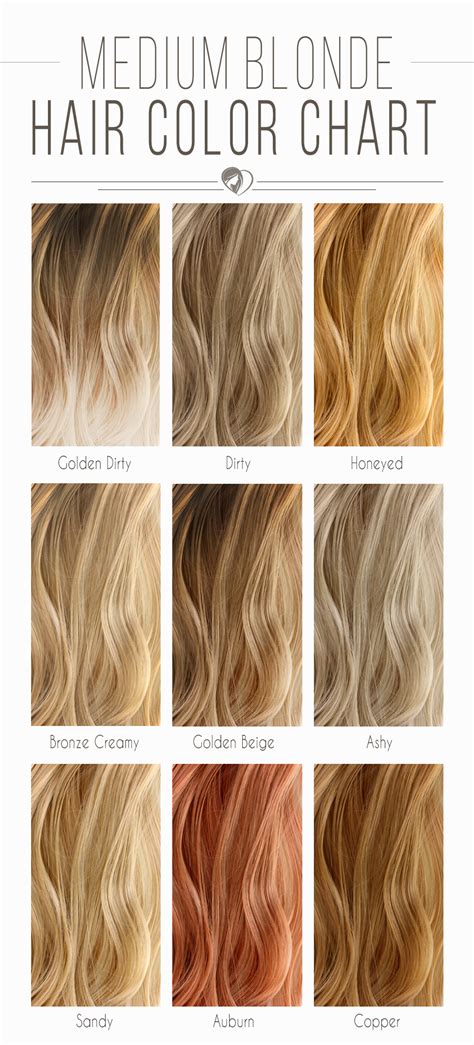Table of Contents

- Blonde Color Chart
- Shades of Blonde
- Natural to Platinum Blondes
- Blonde Hair Color Trends
- Choosing the Right Blonde
- Blonde Color Techniques
- Blonde Hair Care
- Common Mistakes to Avoid
Blonde Color Chart
The blonde color chart categorizes blonde shades into numerical levels, from level 1 (darkest) to level 10 (lightest). This system provides a standardized way to describe blonde hair color, making it easier for stylists and clients to communicate.
| Blonde Level | Description |
|---|---|
| 1 | Black or Dark Brown |
| 2 | Very Dark Brown |
| 3 | Dark Chocolate Brown |
| 4 | Medium Brown |
| 5 | Light Brown |
| 6 | Dark Blonde |
| 7 | Medium Blonde |
| 8 | Light Blonde |
| 9 | Very Light Blonde |
| 10 | Platinum Blonde |
Shades of Blonde
Within the blonde color chart, numerous shades of blonde can be achieved.
Natural Blondes
Natural blondes typically fall between level 6 and level 8 on the blonde color chart. These shades include:
- Strawberry Blonde: A warm, golden blonde with reddish undertones.
- Honey Blonde: A warm, amber-colored blonde with honey-like hues.
- Golden Blonde: A warm, yellow-based blonde with golden undertones.
Cool Blondes
Cool blondes typically fall between level 7 and level 9 on the blonde color chart. These shades include:
- Ash Blonde: A cool, gray-toned blonde with a metallic finish.
- Platinum Blonde: A very light, almost white blonde with a silvery or icy undertone.
- Beige Blonde: A cool, neutral blonde with a beige or sand-like undertone.
Warm Blondes
Warm blondes typically fall between level 6 and level 8 on the blonde color chart. These shades include:
- Caramel Blonde: A warm, copper-infused blonde with rich, caramel-colored undertones.
- Toffee Blonde: A warm, brown-based blonde with golden or copper undertones.
- Butterscotch Blonde: A warm, golden-blonde with a creamy, buttery undertone.
Blonde Hair Color Trends
Blonde hair color trends change season after season. According to a survey by the NPD Group, 45% of women in the United States color their hair, and blonde is the most popular color choice.
Current Blonde Hair Color Trends
Some of the current blonde hair color trends include:
- Bronde: A blend of blonde and brown shades, creating a natural-looking, low-maintenance look.
- Balayage: A freehand painting technique that creates a soft, sun-kissed effect.
- Foilyage: A combination of balayage and foiling, creating a more blended and natural-looking blonde.
- Shadow Root: A technique that leaves the roots darker than the rest of the hair, creating a low-maintenance, grown-out effect.
- Platinum Blonde: A very light, icy blonde that has been a popular trend for several seasons.
Choosing the Right Blonde
Choosing the right blonde color depends on several factors, including:
- Skin tone: Warm skin tones complement warm blonde shades, while cool skin tones complement cool blonde shades.
- Eye color: Blue and green eyes look best with cool blonde shades, while brown and hazel eyes look best with warm blonde shades.
- Personal style: Consider your overall style and personality when choosing a blonde shade.
- Maintenance level: Some blonde shades, such as platinum blonde, require more frequent touch-ups than others.
Blonde Color Techniques
There are several different techniques for achieving blonde hair color, including:
- Bleach: Bleach is a chemical that lightens the hair by removing natural pigments.
- Lightener: Lighteners are less harsh than bleach and are often used to lighten hair by several levels.
- Toner: Toners are used to adjust the tone of blonde hair, adding warmth or coolness as desired.
- Glaze: Glazes are similar to toners but are used to add moisture and shine to blonde hair.
Blonde Hair Care
Blonde hair requires special care to maintain its color and health.
- Use sulfate-free shampoo and conditioner: Sulfates can strip away blonde hair color.
- Deep condition regularly: Deep conditioning helps to repair and nourish blonde hair.
- Use purple shampoo: Purple shampoo helps to counteract brassy tones in blonde hair.
- Protect from the sun: Sun exposure can lighten blonde hair and cause damage.
- Avoid chlorine: Chlorine can turn blonde hair green.
Common Mistakes to Avoid
When coloring blonde hair, there are several common mistakes to avoid:
- Over-bleaching: Over-bleaching can damage hair and make it brittle.
- Using the wrong developer: Using the wrong developer can result in hair that is too light or too dark.
- Bleaching hair that has been previously colored: Bleaching previously colored hair can cause damage and unwanted color results.
- Not using toner: Toner is essential for adjusting the tone of blonde hair and achieving the desired look.
- Not following instructions: Always follow the instructions on hair color products carefully to avoid mistakes.
